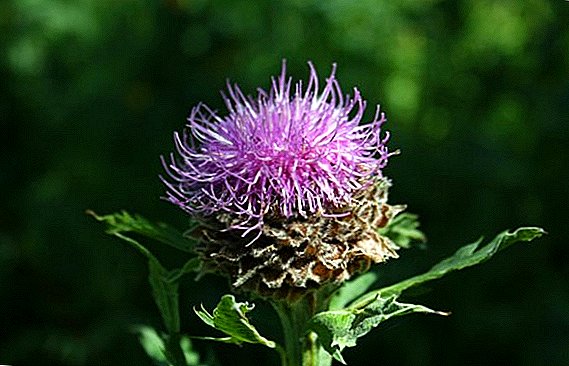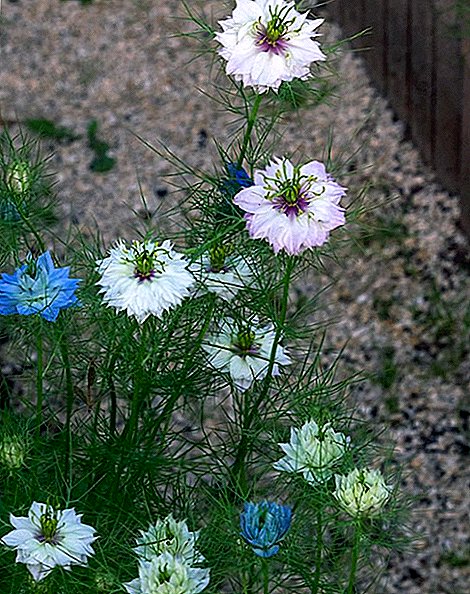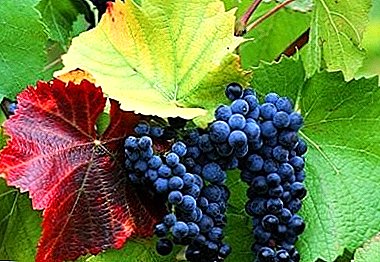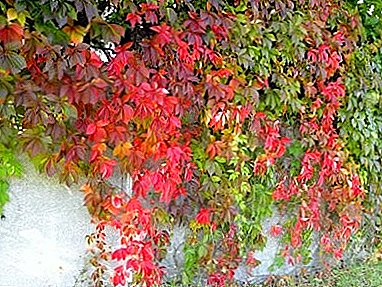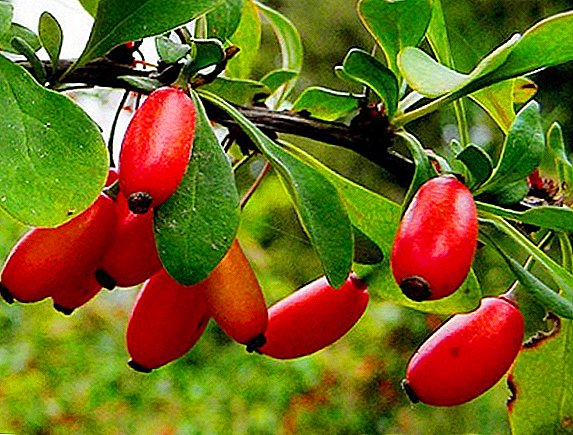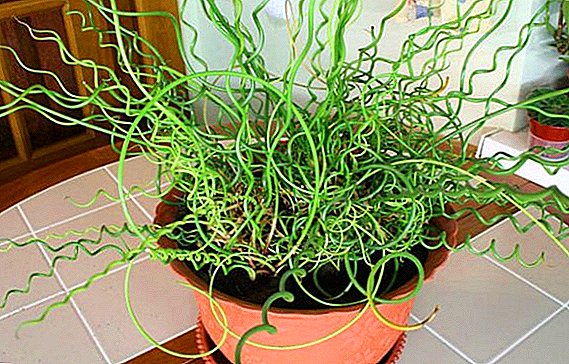 Virgil also mentioned this plant as an excellent material from which to make bedding and baskets. Hence its name, translated from the Latin meaning "to connect", "to connect". Probably, in Kievan Rus, it was also used, including weaving nets, from here one more of its name, titnik came.
Virgil also mentioned this plant as an excellent material from which to make bedding and baskets. Hence its name, translated from the Latin meaning "to connect", "to connect". Probably, in Kievan Rus, it was also used, including weaving nets, from here one more of its name, titnik came.
Short description
The main distinctive feature of a dzhunkus are its stems - extravagant, spiral. The shoots are delicate and long, completely without leaves. At home, it grows to half a meter. Stems hard and narrow, near the base in scaly brown sheaths. Blossoms, inflorescences beige, small flowers. Sharp and narrow twigs spirally spiraling upwards.  In general, the rusk species has a bush with spiral branches growing in all directions.
In general, the rusk species has a bush with spiral branches growing in all directions.
Did you know? There are more than 300 species of junkus hybrids in the world.
Growing conditions
In general, the undemanding rush flower still requires care and supervision. Below we describe how to properly care for the rush.
Lighting
Junkus does not like saturated lighting, and the place where it is located, should be shaded, and diffused artificial lighting. At noon, you need to protect from direct sunlight.
For a pot of junkus fit windows to the east in the summer, but in winter the south or west side is better.
Find out which indoor plants feel better on a sunny balcony or windowsill, and which ones need shade.
Temperature
Sitnik is a heat-loving plant, so it needs to maintain temperature. from +16 to +24 degrees. At a temperature of +15 degrees the rush ceases to grow, spirals become less frequent, the health and decorativeness of the plant deteriorates. Every year, in order for the plant to rest, the temperature must be lowered. Harmful sitnik drafts and overcooling of the soil. 
How to care for a wire plant
This is a non-standard plant, and although it is not difficult to cultivate it, it will be necessary to satisfy the considerable need of the bird in the moisture and it will be necessary to create and maintain conditions as close as possible to the marsh.
Watering
It is necessary to water a junkus very well, since constant soil moisture is a prerequisite for its normal vital activity. The parched soil will destroy it, the leaves will dry out and turn black, and the juncus may not recover, and if it revives, it will not return to its former appearance very soon. Not superfluous and spraying.
There are some peculiarities in the watering of Dzhunkus:
- the water in the pot must always remain at the same level;
- it should cover the drainage below the pot a little;
- in double pots and high pallets, the water should not fall below 8-10 cm.
When watering, the liquid is poured directly into the pot with overflow into the pan or directly into the pan. Water should be soft and well settled at room temperature.
It is interesting to read: 15 of the most beautiful indoor plants, plants for the office, bedroom, nursery.
Air humidity
 The air needs very humid. If the humidity in the room is below 50% or the heating devices are turned on, the plant should be moistened more often, usually this is done with a sprayer. However, it is necessary to take into account that water is sprayed not at the juncus, but at some distance from it in order to create a semblance of fog. But if the air in the room is always dry, then the room should have additional containers with water, an aquarium, etc.
The air needs very humid. If the humidity in the room is below 50% or the heating devices are turned on, the plant should be moistened more often, usually this is done with a sprayer. However, it is necessary to take into account that water is sprayed not at the juncus, but at some distance from it in order to create a semblance of fog. But if the air in the room is always dry, then the room should have additional containers with water, an aquarium, etc.
Important! A sharp decrease in air humidity for junkus is deadly.
Top dressing
Feed every other week from March to October. To do this, use mineral fertilizers for decorative and hardwood, as well as universal fertilizers for indoor plants.
Find out which plants are called ornamental: decorative leafy and decorative flowering.
Pruning
It consists in removing wilted, upright stems, otherwise they will only be a source of rot, bacteria, etc., as well as in the removal of dry shoots and neat pruning of dried ends of the stems. Unhealthy shoots cut off at their base.
Transfer
Transplanting, like irrigation, is an essential component of junkus care. From the constant moisture decomposition of the substrate occurs, it rots, sits down and compresses the root system, also during dormancy of the plant the old roots die, the growth of the junkyus stops, and the leaves deteriorate. Then it is necessary to transplant into fresh, sour and crumbly soil, which is made in spring. Experienced growers recommend transplanting done annually.  The pot should not be very close, but not very large in diameter. It is desirable high, but not spacious, at the bottom you first need to put the drainage of rather big clay on one third of the total capacity of the pot.
The pot should not be very close, but not very large in diameter. It is desirable high, but not spacious, at the bottom you first need to put the drainage of rather big clay on one third of the total capacity of the pot.
Did you know? Sitnik extremely rarely mentioned in the encyclopedia of indoor plants.
Soil need sour and fluffy. In its composition:
- garden land;
- herbal dry fertilizer from plant humus (sphagnum moss, fern roots, river algae) and land;
- ordinary sand (for better drainage).
These components are mixed in equal proportions. In addition, it would be nice to add some more pebbles (river or sea), if not - pumice.
If the rush is sick because it has not been transplanted for a very long time (this can be seen from the spoiled leaves and bulging roots), then at the transplant, these leaves should be cut, besides, you should also carefully examine the roots and cut them if necessary.
Houseplants with decorative leaves are maranta, cordilina, araucaria, zamiokulkas, sheflera, yucca, chlorophytum, nolina, sansevieria, aglaonema, ferns.
In a new pot, rush must be placed at the same depth as in the old pot before transplanting. After the transplantation is completed, the soil will be mulched with expanded clay or decorative stone soil, this will help retain moisture and will not allow the top layer of soil to dry out too much. 
Reproduction by dividing the bush
In the spring, when they are transplanted, they divide the roots of junkus, and in this case it is necessary that each delenka has several root processes. The places where the cut was made are disinfected with wood or activated carbon. Then transplanted into ready-made pots with wet soil. Initially, pots are placed in direct sunlight, and when the first germination occurs, they are removed in the shade.
Important! If there is a cat in the house, keep the junkus away from her.
Possible difficulties
They are few, but they are. The most common problems are:
- in case of insufficient humidity, in the cold or dry air, the leaves of the rush dry and die. In winter, this means that the rush has passed into dormancy and will revive in spring, but if such signs appear in summer, rush is affected by root rot;
- with excessive shading of the rusp, the leaves will lose their color, and the stems will become pale.
Video: junkus - care, problems when growing
Flower grower reviews


Dzhunkus is a rare exotic plant, it will decorate any situation with its interesting dissimilarity. In addition, this plant can positively affect the microclimate of the room in which it is located.


